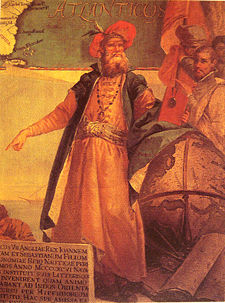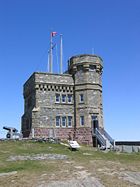John Cabot
2008/9 Schools Wikipedia Selection. Related subjects: Geographers and explorers
| John Cabot | |
 John Cabot in traditional Venetian garb, from a sixteenth-century painting
|
|
| Born | 1450 Genoa, Italy |
|---|---|
| Died | 1498 (aged 47–48) Unknown |
| Nationality | Genoese |
| Occupation | Maritime explorer |
| Title | Admiral of the Ocean Sea |
| Religious beliefs | Roman Catholic |
| Children | Ludovico, Sebastian, and Sancto |
Giovanni Caboto ( c. 1450 – c. 1498), known in English as John Cabot, was an Italian navigator and explorer commonly credited as the first European to discover North America, in 1497, notwithstanding Norseman Leif Ericson's landing (c. 1003). The Canadian and United Kingdom government's official position is that he landed on the island of Newfoundland.
Biography
Cabot's birthplace is a matter of much controversy with Italian ( Venice, Gaeta or Castiglione Chiavarese having been proposed as birthplaces), English, or Catalan roots all being possibilities. When he was eleven, he moved to Venice and became a Venetian citizen.
Like other Italian explorers of the era, such as Christopher Columbus, Cabot made another country his base of operations. It was probably on hearing of Columbus's discovery of 'the Indies' that he decided to find a route to the west for himself. He had a simple plan, to start from a northerly latitude where the longitudes are much closer together, and where, as a result, the voyage would be much shorter.
Cabot sought funding from England and so his explorations were made under the English flag.
King Henry VII of England gave him a grant to go on
| “ | full and free authority, leave, and power, to sail to all parts, countries, a see as, of the East, of the West, and of the North, under our banners and ensigns, with five ships ... and as many mariners or men as they will have in said ships, upon their own proper costs and charges, to seek out, discover, and find, whatsoever isles, countries, regions or provinces of the heathen and infidels, whatsoever they be, and in what part of the world soever they be, which before this time have been unknown to all Christians. | ” |
|
— Henry VII of England
|
Cabot went to Bristol to make the preparations for his voyage. Bristol was the second-largest seaport in England, and during the years from 1480 onwards several expeditions had been sent out to look for Hy-Brazil, an island said to lie somewhere in the Atlantic Ocean according to Celtic legends. In 1496 Cabot set out from Bristol with one ship. But he got no further than Iceland and was forced to return because of disputes with the crew.
On a second voyage Cabot again used only one ship with 18 crew, the Matthew, a small ship (50 tons), but fast and able. He departed on either May 2 or May 20, 1497 and sailed to Dursey Head (latitude 51°36N), Ireland. He landed on the coast of Newfoundland on June 24, 1497. His precise landing-place is a matter of controversy, with Bonavista or St. John's in Newfoundland, Cape Breton Island, Nova Scotia, Labrador, or Maine all being possibilities. Cape Bonavista, however, is the location recognised by the governments of Canada and the United Kingdom as being Cabot's official landing. His men may have been the first Europeans to set foot on the North American mainland since the Vikings. Christopher Columbus did not find the South American mainland until his third voyage, in 1498, and letters referring to a voyage by Amerigo Vespucci in 1497 are generally believed to have been forgeries or fabrications. Cabot went ashore to take possession of the land, and explored the coast for some time, and departed on July 20. On the homeward voyage his sailors incorrectly thought they were going too far north, so Cabot sailed a more southerly course, reaching Brittany instead of England, and on August 6 arrived back in Bristol.
Back in England, Cabot was made an Admiral, rewarded with £10 and a patent was written for a new voyage. Later, a pension of £20 a year was granted to him. The next year, 1498, he departed again, with 5 ships this time. One of the ships returned to an Irish port because of damage taken on in an storm. Upon repair the ship again headed west. Cabot and his expedition were never heard from again and are presumed to have been lost at sea.
Sebastian's Voyage
John's son, Sebastian Cabot, later made a voyage to North America, looking for the hoped for Northwest Passage ( 1508), and another to repeat Magellan's voyage around the world, but which instead ended up looking for silver along the Río de la Plata (1525-8).
Tributes
Along with Cabot Tower in St. John's, Newfoundland, Cabot is remembered in Bristol, England by the Cabot Tower, a 30-metre tall red sandstone tower of 1897 (the 400th anniversary of the landing) on Brandon Hill near the city centre, by a replica of the Matthew built in the city and by a statue of the explorer on the harbour side.
Cabot is also the namesake of John Cabot University, an American university established in 1972 in Rome, Italy.
The Scenic Cabot Trail in the Highlands of Cape Breton is also named after the explorer
The new shopping quarter in central Bristol (Cabot Circus) is named after him.
